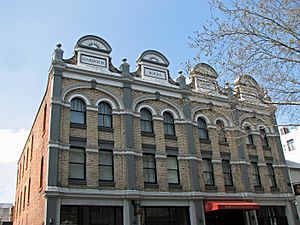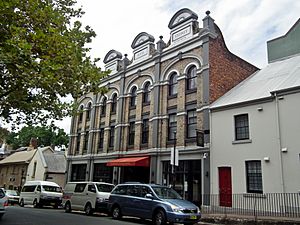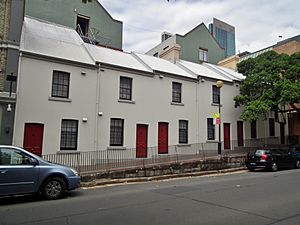Harbour Rocks Hotel facts for kids
Quick facts for kids Harbour Rocks Hotel |
|
|---|---|

Harbour Rocks Hotel, pictured in 2018
|
|
| Location | 34-40 and 42-52 Harrington Street, The Rocks, City of Sydney, New South Wales, Australia |
| Built | 1873–1875; 1890 |
| Built for | George Evans |
| Owner | Property NSW |
| Official name: Evans' Stores, Harbour Rocks Hotel; Evans' Stores; Hotel also occupies Terraces at 42-52 Harrington Street | |
| Type | State heritage (built) |
| Designated | 10 May 2002 |
| Reference no. | 1545; 1611 |
| Type | Hotel |
| Category | Commercial |
| Lua error in Module:Location_map at line 420: attempt to index field 'wikibase' (a nil value). | |
The Harbour Rocks Hotel is a special building in The Rocks, a historic area in Sydney, Australia. It's a place that has been many things over the years: a pub, a hotel, shops, and even a warehouse. It also includes old terrace cottages. This building is important because it's listed on the New South Wales State Heritage Register, which means it's protected for its history.
The hotel was built in two main stages: first from 1873 to 1875, and then again in 1890 for a man named George Evans. That's why it was once known as Evans' Stores. Today, it's a four-star hotel and part of a well-known hotel group. It even has a restaurant and bar called Lanes Restaurant & Bar.
A Look Back: The Hotel's Story
The land where the hotel stands was once part of a hospital garden. Maps from the 1830s show it was set aside for a church.
How the Land Changed Hands
In 1836, a man named David Smith was promised this land by Governor Macquarie for his work as a sailor. Smith sold it soon after. Later, the land was divided and sold many times. In the 1840s, William Adnum bought one part, and then William Riley bought both parts.
Riley was the first to build a lot on the site. He put up ten houses, some made of stone and some of brick. These houses were built close together, which was common in The Rocks back then. A small lane next to the houses was first called 'Riley's Lane', then 'Reynolds Lane', and finally 'Harrington Place'.
From Houses to a Big Store
Over the years, the houses were rented out. In the 1850s, some were even used as lodging houses for sailors. The land became very valuable, especially after the gold rush made city land prices go up.
Eventually, in the 1880s, two solicitors, Richard Holdsworth and George Evans, bought the properties. They tore down the old houses in 1885-1886 and built a new, large four-storey store in 1887. This building, known as Evans' Stores, had separate entrances for loading goods and could be used by different businesses.
A Place for the Unemployed
In the 1890s, during a time when many people didn't have jobs, part of the building was used as a barracks for unemployed single men. Groups like the Australian Order of Industry and the Active Service Brigade helped these men by offering a bed and breakfast for a small fee. They wanted to help people keep their self-respect. This barracks was first called the Wentworth Falls barracks, but then changed to Liberty Hall in 1896. It was a place for lectures and education too, and stayed open until about 1900.
New Businesses and Government Ownership
After 1900, the building was used by different businesses, like the John Gainsford's Australian Broom Factory. The government eventually took over the property. From 1905 to the 1930s, the stores were home to many different companies, including importers, chemists, and even a sheep shearing machinery business. The Joplin Manufacturing Company was one of the longest-running tenants, staying there from 1903 until 1971.
Saving the Building: The Green Bans
In the 1970s, there were plans to knock down the building as part of a redevelopment of The Rocks. However, local workers and community groups, supported by "Green Bans" (a type of protest where workers refuse to demolish historic buildings), stopped this from happening. This helped save the building.
Becoming the Harbour Rocks Hotel
By the 1980s, the building needed a lot of repairs. To help pay for this, the government looked for a developer. In 1986, the Tara Hotel Group suggested turning the old stores and the nearby terraces into a hotel. This new development happened in 1988, and the Harbour Rocks Hotel officially opened in 1989. Since then, it has been updated with things like disabled access and new restaurant areas. In 2012, the hotel was refurbished to bring back its historic feel while adding modern comforts to its 59 rooms.
The Terraces at 42–52 Harrington Street
The land for these terraces was granted in 1871 and then sold to Henry Bradburn Dobson, a builder. He built six terrace houses facing Harrington Street, and another six at a lower level behind them. These houses were completed around 1875. They were rented out to respectable tenants, often tradesmen, and usually had backyards.
After the government took over these properties in 1900, the six houses at the back were demolished between 1911 and 1914. The remaining houses on Harrington Street were repaired and renovated over the years. In the late 1980s, these terraces were combined with the old stores to create the new Harbour Rocks Hotel, giving them a new life.
What the Hotel Looks Like
The Old Evans' Stores (34–40 Harrington Street)
This part of the hotel used to be Evans' Stores. It's a striking three-storey brick building with a painted front. It has four decorative pediments (triangle-shaped parts) at the top, each with a sunrise design. The front is divided into four sections by pilasters (flat columns) that have decorative tops called finials. When it was turned into a hotel in 1989, shops, bars, and restaurants were added at the back, facing Nurses Walk.
Building Condition
As of 2001, the ground underneath the building had been mostly disturbed, but there were still archaeological remains above ground.
Changes Over Time
- 1907: Sewer lines were connected.
- Mid 1960s: The building was used for workshops, offices, and even an art gallery.
- 1978: A raised wooden walkway was built to connect the lowest floor to Nurses Walk.
- 1979: The lane next to the building changed its name from Harrington Place to Suez Canal.
- By 1989: The old warehouse and the terraces next door were turned into the Harbour Rocks Hotel.
The Terraces (42–52 Harrington Street)
These are six two-storey terrace houses made of brick, with a painted finish. They step up along Harrington Street. Their roofs are steeply sloped and made of corrugated iron. The windows have twelve panes and sandstone sills, with a flat brick arch above them. When they became part of the hotel in 1989, the front rooms were kept as individual hotel suites, and new hallways and bathrooms were added.
Building Condition
As of 2009, it's believed that archaeological remains, like old wells or cesspits, might still be found underground.
Changes Over Time
- By 1989: The terraces were converted into part of the Harbour Rocks Hotel.
Why It's a Heritage Site
The Harbour Rocks Hotel and its land, including the old cottages, are very important to the history and culture of New South Wales. They are also a key part of The Rocks area, which is itself a very important heritage site.
The hotel's land is historically significant because it was once part of the first hospital gardens and then had buildings on it from 1850 until Evans' Stores was built in 1887. Evans' Stores shows us what commercial buildings looked like in The Rocks in the 1800s.
The building is also beautiful and unique. It's an unusual and impressive warehouse that stands out on Harrington Street, with Suez Canal on one side and the terraces on the other. It helps create a strong visual look with other historic buildings nearby. The terrace cottages are also important because they show what working-class homes looked like in The Rocks and other parts of Sydney in the late 1800s.
The Harbour Rocks Hotel was officially listed on the New South Wales State Heritage Register on 10 May 2002 because it met several important criteria:
- It shows how history unfolded in New South Wales: The site's journey from a hospital garden to a warehouse shows the changing history of the area.
- It has a special look and design: The hotel is a great example of a Late Victorian Italianate Style warehouse, with its grand pediments and balanced design. It adds a lot to the street. The terraces also contribute to the historic streetscape.
- It has the potential to teach us more about history: Any old remains from the hospital garden or early buildings could tell us more about how the area developed.
- It shows important features of its type: The old stores building is a good example of a Late Victorian warehouse, still showing features like loading platforms. The terraces are typical of working-class homes from the late 1800s in The Rocks.



